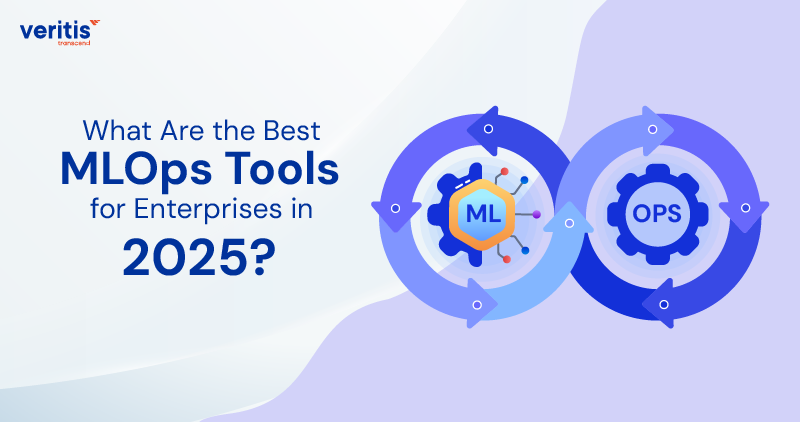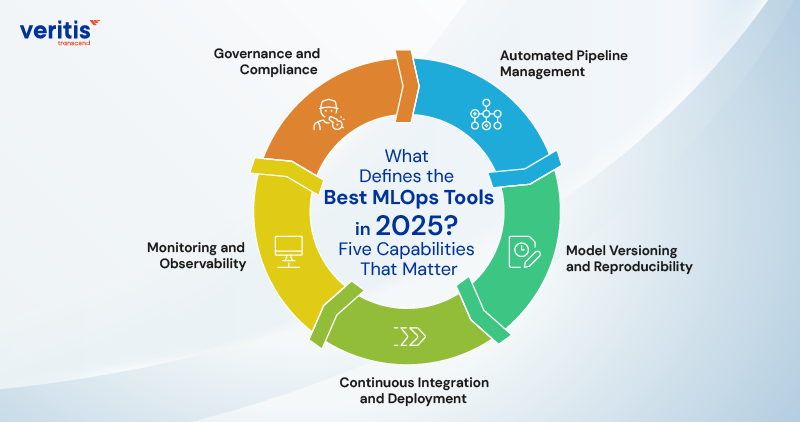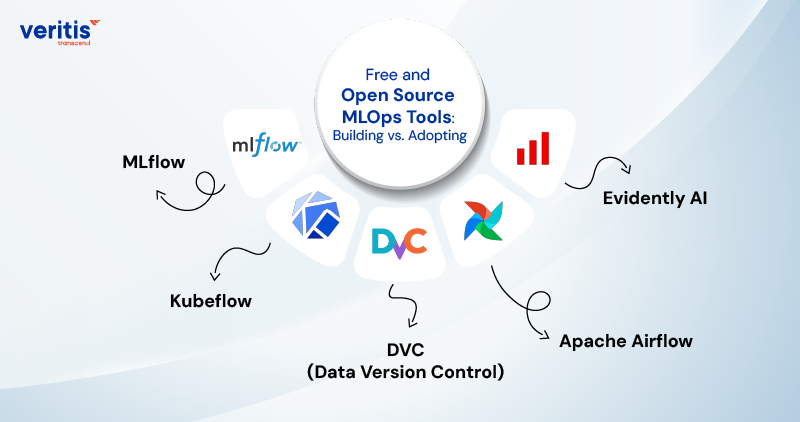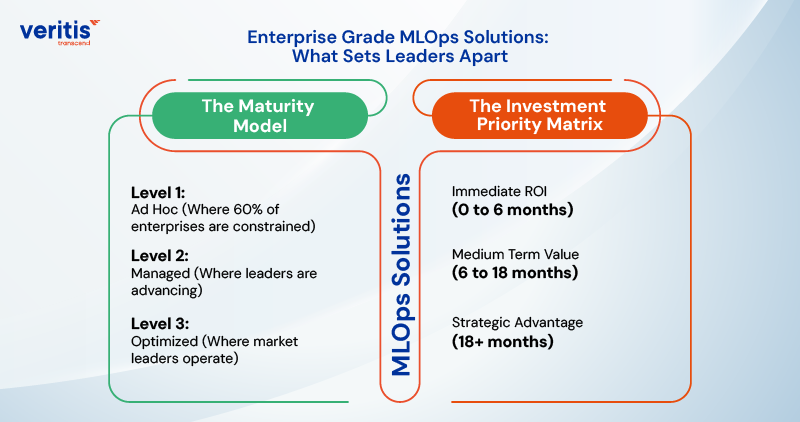
For years, companies have invested substantial capital in artificial intelligence, pursuing the promise of automation, more thoughtful decisions, and a competitive edge. But here’s the hard truth: most of those investments still haven’t paid off.
Think about it. You’ve hired brilliant data scientists. You’ve signed off on massive cloud contracts. You’ve built models with accuracy over 95%. And yet…nothing in production. No measurable revenue impact. No transformation story for the boardroom.
If that sounds familiar, you’re not alone. Analysts estimate that nearly nine out of ten AI projects fail to deliver business value before completion. The problem is not all about the science. It’s the messy, operational gap between a working model and a working product.
- Almost 90% of AI projects fail to deliver measurable business value, making it critical for CEOs, CTOs, CIOs, and CFOs to focus on MLOps as the bridge between prototypes and production.
- Enterprises adopting MLOps experience up to 8x cost reduction, deployment cycles reduced from months to weeks, and risk minimized, with 99.9% of failures caught before customer impact.
- For Fortune 500 organizations, MLOps maturity has already translated into billions in revenue, faster innovation, and long term competitive advantage.
- Veritis enables top executives to achieve the same outcomes by aligning AI with business goals, accelerating deployment by 75%, reducing inference costs by 60%, and ensuring AI investments deliver sustainable enterprise growth.
That’s where MLOps tools come into play. In 2025, the companies leading the way, Amazon, Google, Microsoft, and Tesla, are not succeeding because they’ve cornered the market on talent. They’re excelling because they’ve mastered the operational side: the tools for machine learning that keep models alive in production, and the MLOps pipeline tools that ensure experiments turn into reliable, revenue generating systems.
The question for enterprises is not “Can machine learning create value?” That debate is long settled. The real question is: Can you scale it, reliably, securely, and profitably?
This resource delivers a detailed overview of the top MLOps tools in 2025: the platforms enterprises are relying on to bridge the gap between prototype and production, ultimately transforming AI into a driver of measurable growth.
What Are MLOps Tools?
Think of MLOps tools as the operational backbone of your AI efforts. Just like a manufacturing plant relies on production lines, quality checks, and logistics to run smoothly, enterprise AI needs a structured system to manage data, models, and deployment. That’s where machine learning pipelines come in; they keep everything moving, consistent, and reliable.
MLOps tools encompass the entire ecosystem that takes a data scientist’s model from prototype to production powerhouse. These tools for machine learning handle everything from data versioning and model training to deployment monitoring and AI governance. They’re the invisible infrastructure that makes AI actually work at scale.
Think of MLOps tools as your AI factory’s assembly line.
Without MLOps: Your AI models are handcrafted artisanal products, beautiful, unique, and impossible to scale.
With MLOps: Your AI models become mass produced powerhouses, consistent, reliable, and delivering measurable value 24/7.
The best MLOps tools are the invisible infrastructure that transforms your $50M AI investment from a science experiment into a competitive advantage.
The MLOps Advantage: By The Numbers
1) Speed Advantage
- Traditional ML Deployment: 6 to 12 months
- With MLOps Tools: 2 to 4 weeks
- Result: Deploy recommendation updates daily, driving $1B+ in viewer engagement
2) Cost Optimization
- Infrastructure Cost Reduction: Up to 8x lower
- Development Speed: 4x faster model training
- ROI Impact: Companies report 300 to 500% ROI within the first year
3) Risk Mitigation
- Model Failures Identified: 99.9% before customer impact
- Compliance Violations: Near zero with a proper MLOps governance framework
- Audit Readiness: Real time compliance reporting
Useful Link: Top 15 AWS Machine Learning Tools in the Cloud
How Do Fortune 500 Leaders Operationalize MLOps Excellence?
1) Amazon’s Strategic Advantage
Amazon runs over 100,000 machine learning models in production. Their MLOps architecture processes 4.9 billion predictions daily for everything from product recommendations to supply chain optimization. Result? $469 billion in annual revenue with AI driving 35% of purchases.
2) Google’s AI Assembly Line
Google deploys thousands of models monthly using its internal MLOps tools. Their production ML systems power Search, YouTube, and Gmail, generating over $ 280 billion annually. Their MLOps pipeline tools enable this massive scale through complete automation.
3) Microsoft’s Enterprise Advantage
Microsoft’s Enterprise MLOps 2025 strategy powers LinkedIn’s job recommendations, Office 365’s intelligent features, and Azure’s AI services. Their MLOps tools for enterprises process over 30 trillion ML inferences annually.
What Defines the Best MLOps Tools in 2025? Five Capabilities That Matter

1) Automated Pipeline Management
Traditional software deployment is child’s play compared to ML deployment. Your models require data preprocessing, feature engineering, training orchestration, and validation, all of which must be completed before they are deployed in production. Machine learning pipeline tools automate these workflows, eliminating the manual handoffs that slow down progress.
2) Model Versioning and Reproducibility
When your fraud detection model suddenly starts flagging legitimate transactions, you need to know precisely what changed. The best MLOps tools provide comprehensive versioning that tracks not only code but also data, parameters, and environment configurations.
3) Continuous Integration and Deployment
Models in production require continuous iteration through retraining, A/B testing, and gradual rollouts. MLOps best practices, supported by robust MLOps tools, enable continuous delivery and monitoring workflows that keep AI systems up to date, reliable, and competitive.
4) Monitoring and Observability
Production models drift, data changes, and performance degrades. Tools for machine learning provide real time monitoring that alerts you before your customers notice problems.
5) Governance and Compliance
In regulated industries, model explainability and audit trails are mandatory for compliance and accountability. Enterprise MLOps solutions offer AI governance frameworks that ensure compliance while enabling rapid progress.
Useful Link: What is Cognitive Robotic Process Automation and How Does It Enhance Intelligent Automation?
Key Features That Define Best in Class MLOps Tools
When evaluating MLOps tools, executives should prioritize capabilities that drive business outcomes over technical features. The best MLOps tools deliver on these enterprise requirements:
1) End to End Workflow Orchestration
Your machine learning pipeline tools should handle the complete ML lifecycle without requiring duct tape integrations. From data ingestion through model retirement, seamless workflow orchestration eliminates the integration nightmares that plague fragmented toolchains.
2) Multi Cloud and Hybrid Deployment
Vendor lock in is a strategic risk. The best MLOps platforms for enterprises provide deployment flexibility across AWS, Azure, Google Cloud, and on-premises infrastructure. This flexibility becomes crucial when regulatory requirements or cost optimization drive decisions about infrastructure.
3) Real Time Model Monitoring
Production models fail silently. Feature drift, data quality issues, and performance degradation require continuous monitoring. Enterprise MLOps 2025 platforms offer intelligent alerting that detects issues before they impact business metrics.
4) Automated Model Lifecycle Management
Manual model updates lack scalability in enterprise environments. The top tools to reduce ML inference costs in 2025 offer automated retraining, validation, and deployment pipelines that keep models up to date without requiring human intervention.
5) Enterprise Security and Governance
Your ML models process sensitive data and make business critical decisions. Enterprise grade MLOps solutions provide role based access control, audit logging, and compliance reporting that meet enterprise security standards.
The 10 Most Advanced MLOps Tools Dominating 2025

Tier 1: The Enterprise Leaders
1) Amazon SageMaker
- Market Leadership: Commands 34% enterprise market share
- Strength: Deepest cloud integration, managed everything
- Target Profile: AWS committed organizations seeking MLOps as a service
- Cost Impact: Automated enterprise AI scaling reduces inference costs by 60%
2) Microsoft Azure ML
- Enterprise Focus: Built for regulated industries
- Strength: Unmatched MLOps governance framework capabilities
- Target Profile: Microsoft ecosystem organizations
- Compliance Edge: Fastest SOC2, HIPAA, PCI DSS certification
3) Google Vertex AI
- AI Leadership: Leverages Google’s research advantage
- Strength: AutoML and large scale training capabilities
- Ideal Fit: Data heavy organizations needing advanced machine learning pipeline tools
- Technical Edge: Handles petabyte scale training workloads
Tier 2: The Flexibility Leaders
4) MLflow
- Adoption: 10M+ downloads, industry standard
- Strength: Vendor neutrality and customization
- Ideal Fit: Multi cloud strategies and MLOps tool comparison flexibility
- Cost Advantage: Open source with enterprise support options
5) Kubeflow
- Technical Leadership: Kubernetes native architecture
- Strength: Hybrid cloud and edge machine learning deployment
- Ideal Fit: Container first organizations
- Scalability: Manages thousands of concurrent training jobs
Tier 3: The Specialized Specialists
6) DataRobot
- Automation Focus: Citizen data scientist enablement
- Strength: Rapid model development and deployment
- Ideal Fit: Organizations lacking deep ML expertise
- Speed Advantage: 10x faster model development cycles
7) Databricks
- Unified Platform: Data engineering + ML operations
- Strength: End to end data science workflows
- Ideal Fit: Analytics heavy organizations
- Collaboration Edge: Best team productivity features
8) Domino Data Lab
- Enterprise Design: Built for large data science teams
- Strength: Governance and collaboration at scale
- Ideal Fit: 50+ data scientist organizations
- Productivity Impact: 3x faster experiment cycles
9) H2O.ai
- AI Automation: Driverless AI capabilities
- Strength: Model interpretability and explainability
- Ideal Fit: Regulated industries requiring model transparency
- Compliance Strength: Built in bias detection and fairness metrics
10) Iguazio
- Speed Focus: Ultra low latency inference
- Strength: Real time ML pipeline orchestration
- Ideal Fit: Financial services and fraud detection
- Performance Edge: Sub millisecond model serving
Useful Link: Why Every CEO Needs an IT Strategy Roadmap for Digital Growth
Free and Open Source MLOps Tools: Building vs. Adopting

Smart executives evaluate both commercial and open source options. The leading open source MLOps tools include:
1) MLflow
The standard for experiment tracking and model registry, MLflow, provides vendor neutral tools for machine learning lifecycle management.
2) Kubeflow
Container native machine learning pipeline tools that provide production scale orchestration on Kubernetes infrastructure.
3) DVC (Data Version Control)
Git like version control for data and models is essential to a reproducible MLOps architecture.
4) Apache Airflow
Workflow orchestration is a foundational tool many enterprises use to automate machine learning pipelines.
5) Evidently AI
Open source model monitoring and data drift detection for production MLOps tools.
However, the total cost of ownership calculation often favors managed MLOps Services. While open source tools eliminate licensing costs, they require significant engineering investment for integration, maintenance, and support. Most enterprises find that MLOps Solutions from established vendors provide better ROI when factoring in opportunity costs and time to value.
MLflow vs SageMaker vs Azure ML vs Vertex AI: The Platform Showdown
The MLflow vs SageMaker vs Azure ML vs Vertex AI comparison represents the core platform decision most enterprises face:
1) MLflow offers maximum flexibility and vendor neutrality, but it requires a significant operational investment. It’s ideal for organizations with strong MLOps engineering capabilities that prioritize customization and multi cloud deployment.
2) SageMaker offers the most comprehensive managed MLOps Services within the AWS ecosystem. Its strength lies in deep integration with AWS services and automated infrastructure management. However, it creates an AWS dependency that may conflict with multi cloud strategies.
3) Azure ML excels in Microsoft centric environments with strong integration to Azure services and enterprise authentication systems. It provides a robust MLOps governance framework with capabilities essential for regulated industries.
4) Vertex AI leverages Google’s AI expertise, featuring strong AutoML capabilities and seamless integration with Google’s data analytics stack. It’s particularly powerful for organizations with significant Google Cloud investments or advanced AI research requirements.
The optimal choice depends on your existing cloud commitments, governance requirements, and internal ML expertise. Most enterprises find that MLOps Consulting Services help navigate these complex platform decisions by providing objective assessments of organizational needs and platform capabilities.
Enterprise Grade MLOps Solutions: What Sets Leaders Apart

A) The Maturity Model
Level 1: Ad Hoc (Where 60% of enterprises are constrained)
- Manual model deployment
- No version control
- Limited monitoring
- Business Impact: High failure rates, unpredictable costs
Level 2: Managed (Where leaders are advancing)
- Automated pipelines
- Basic monitoring
- Version control
- Business Impact: Faster deployment, reduced risk
Level 3: Optimized (Where market leaders operate)
- Continuous optimization
- Predictive monitoring
- Advanced governance
- Business Impact: Competitive advantage, maximum ROI
B) The Investment Priority Matrix
Immediate ROI (0 to 6 months)
- Automated model deployment
- Basic monitoring and alerting
- CI/CD pipeline implementation
Medium Term Value (6 to 18 months)
- Advanced monitoring and optimization
- Governance and compliance frameworks
- Multi model management at scale
Strategic Advantage (18+ months)
- Predictive maintenance and optimization
- Advanced AutoML and meta learning
- Cross functional AI capability development
Useful Link: Generative AI vs Predictive AI, A Strategic Guide for the C-Suite
ROI Analysis: The MLOps Investment Business Case
The Investment Breakdown
Year 1 Costs
- Platform Licensing: $200K to 500K (managed) vs. $0 to 50K (open source)
- Implementation Services: $300K to 800k, depending on complexity
- Training and Change Management: $100K to 200K
- Infrastructure: $100K to 300K additional cloud costs
Total Year 1 Investment: $700K to 1.8M
The Return Calculation
Direct Cost Savings
- Infrastructure Optimization: $500K to 2M annually
- Operational Efficiency: $300K to 800K in reduced manual work
- Faster Time to Market: $1M to 5M in accelerated revenue
Revenue Generation
- New AI Driven Products: $5M to 50M additional revenue
- Improved Customer Experience: 10 to 30% increase in customer lifetime value
- Competitive Advantage: Market share protection and growth
Total Annual Return: $6.8M to 58M
The ROI Reality: 300 to 2000% Returns
Leading organizations report an ROI ranging from 300% for basic implementations to over 2000% for comprehensive Enterprise MLOps 2025 transformations.
The Veritis Advantage: Your MLOps Success Partner
Why 73% of MLOps Implementations Fail
- Lack of Strategic Vision: Technology first instead of a business first approach
- Insufficient Expertise: Underestimating complexity and requirements
- Poor Change Management: Ignoring organizational and cultural factors
The Veritis Difference: MLOps Services That Deliver
A) Strategic MLOps Consulting
- Business Alignment: Connect AI initiatives to revenue outcomes
- Technology Selection: Navigate complex MLOps tool comparison decisions
- Roadmap Development: Phased implementation for maximum ROI
B) End to End MLOps Solutions
- Architecture Design: Scalable MLOps architecture for enterprise needs
- Implementation Excellence: Proven deployment methodologies
- Governance Framework: Comprehensive MLOps governance framework implementation
C) MLOps as a Service
- Managed Operations: 24/7 monitoring and optimization
- Continuous Improvement: Regular performance tuning and cost optimization
- Strategic Advisory: Ongoing guidance for AI strategy evolution
D) Proven Results That Matter
- Deployment Speed: 75% faster time to production
- Cost Optimization: 60% reduction in inference costs
- Operational Excellence: 90% improvement in model monitoring and reliability
Conclusion
The AI revolution is not waiting for your organization to figure out MLOps tools. Every day without a proper machine learning pipeline is a lost competitive advantage and an increase in technical debt.
Begin by assessing your current ML operational maturity. Identify the gaps between your AI objectives and operational capabilities. Partner with MLOps Consulting Services to bridge those gaps with proven MLOps Solutions.
Veritis’ MLOps Services provide the strategic guidance and technical expertise needed to transform your AI initiatives from experimental projects into competitive advantages. Our MLOps as a service approach ensures you capture the full value of Enterprise MLOps 2025 while minimizing implementation risk.
The companies that succeed with AI in 2025 won’t be those with the best algorithms; they’ll be those with the most operationally mature MLOps architecture. The time to act is now.